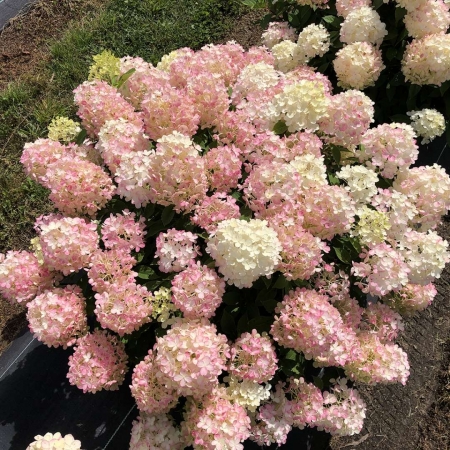Hydrangea paniculata (Hardy Hydrangea)
×
Color Name: Fire Light Tidbit®
This adorable dwarf hydrangea has a low, mounded habit and is packed with color! The late-season blooms emerge a bright lime green, transition to white, and quickly take on hues of dragon fruit pink. A perfect, little front of the border plant to pair with Supertunia Vista Bubblegum. As an added bonus, it will often give you a nice display of orange-red autumn foliage.
Growing Tips: Panicle hydrangeas are the most sun tolerant hydrangeas and are also resistant to wilting. In cooler climates, full sun is recommended for best stem strength and flower set. Flower color is unaffected by soil chemistry. If flowers turn brown and dry instead of aging to pink or red, this indicates that the plant needs more water or that nighttime temperatures are too high for the transition to occur.
Soil: Adaptable to most any soil except very wet or excessively alkaline soils.
Pruning: In late winter or early spring, cut back by about one-third its total height, just above a set of large buds. This ensures that the growth for the season will come vigorous buds lower on the plant and also serves to remove any remaining dried blooms. Alternatively, cut back in autumn once the plant has gone completely dormant. May be cut back harder if desired, though this tends to produce stems that are unable to achieve maximum stem strength the following season.
Uses: Specimen; mixed borders; mass plantings. Makes a good hedge or screen. Excellent for cut flowers, both fresh and dried.
Photo courtesy of Spring Meadow Nursery, Inc.
This adorable dwarf hydrangea has a low, mounded habit and is packed with color! The late-season blooms emerge a bright lime green, transition to white, and quickly take on hues of dragon fruit pink. A perfect, little front of the border plant to pair with Supertunia Vista Bubblegum. As an added bonus, it will often give you a nice display of orange-red autumn foliage.
Growing Tips: Panicle hydrangeas are the most sun tolerant hydrangeas and are also resistant to wilting. In cooler climates, full sun is recommended for best stem strength and flower set. Flower color is unaffected by soil chemistry. If flowers turn brown and dry instead of aging to pink or red, this indicates that the plant needs more water or that nighttime temperatures are too high for the transition to occur.
Soil: Adaptable to most any soil except very wet or excessively alkaline soils.
Pruning: In late winter or early spring, cut back by about one-third its total height, just above a set of large buds. This ensures that the growth for the season will come vigorous buds lower on the plant and also serves to remove any remaining dried blooms. Alternatively, cut back in autumn once the plant has gone completely dormant. May be cut back harder if desired, though this tends to produce stems that are unable to achieve maximum stem strength the following season.
Uses: Specimen; mixed borders; mass plantings. Makes a good hedge or screen. Excellent for cut flowers, both fresh and dried.
Photo courtesy of Spring Meadow Nursery, Inc.
|
Flower Color: Pink/Green Shades Foliage Color: Green Shades
Height: 2 to 3 Feet Spread: 2 to 3 Feet Hardy in Zone: 4, 5, 6 |
Blooms: Summer to Fall
Foliage Season: All Season |
Growth Rate |
Medium
|
Attributes |
Container Extended Bloomer Dried Flower Landscapes Mass Planting Easy to Grow Cut Flower or Foilage Border Specimen Plant
|





